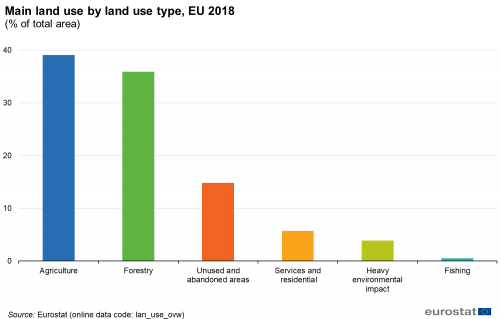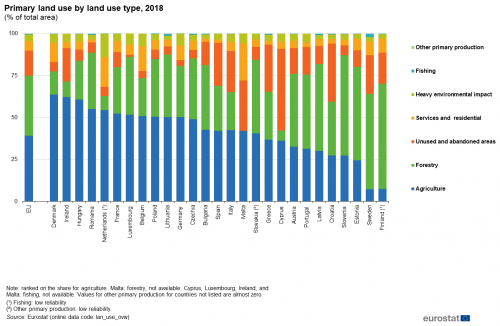
Land Use
Land use
An area of land can be used in parallel for many different purposes: for example, a forest may be used for forestry, for hunting, or for recreation; it is important to note that the statistics that follow are based on the primary (or main) use.
Agricultural land use is the most common primary land use category in the EU; it accounted for 39.1% of the total area in 2018 (see Figure 1). Areas used primarily for forestry covered 35.9% of the EU area, while 14.8% of the area of the EU was unused or abandoned (note that the LUCAS survey is based on field visits and that land use is determined on the basis of visible signs of land use when surveyed). A much lower share (5.7%) of the total area of the EU was used for services and residential purposes (including commerce, finance and business; community services; recreation, leisure and sport; residential; and nature reserves), while uses with a heavy environmental impact (including mining and quarrying; energy production; industry; water and waste treatment; and construction) claimed a further 3.9%, leaving just 0.5% that was used primarily for fishing.
Land under agricultural use encompasses various land cover types: the most common are arable land, permanent crops and grassland. Small portions of other land cover types such as artificial land (for example, farm buildings or roads) and water (for example, irrigation ponds) can also be in agricultural use. In 12 out of the EU Member States, more than half of the total area was used for agricultural purposes in 2018 (see Figure 2). The highest share of agricultural land use was recorded in Denmark (63.7%), while Ireland and Hungary each reported shares that were close to three fifths. In Finland and Sweden, agriculture played a minor role in terms of land use, accounting for less than 10.0 % of the total land area in both of these Member States; the next lowest share is observed in Estonia (24.5%).
Unsurprisingly, forestry was often the dominant land use in those EU Member
SDGs, Targets, and Indicators
SDGs Addressed or Connected to the Issues Highlighted in the Article:
- SDG 15: Life on Land
- SDG 11: Sustainable Cities and Communities
- SDG 13: Climate Action
Specific Targets Under Those SDGs Based on the Article’s Content:
- SDG 15.1: By 2020, ensure the conservation, restoration, and sustainable use of terrestrial and inland freshwater ecosystems and their services, in particular forests, wetlands, mountains, and drylands, in line with obligations under international agreements.
- SDG 11.7: By 2030, provide universal access to safe, inclusive, and accessible, green, and public spaces, in particular for women and children, older persons, and persons with disabilities.
- SDG 13.1: Strengthen resilience and adaptive capacity to climate-related hazards and natural disasters in all countries.
Indicators Mentioned or Implied in the Article:
- Percentage of land used for agriculture
- Percentage of land used for forestry
- Percentage of land unused or abandoned
- Percentage of land used for services and residential purposes
- Percentage of land used for heavy environmental impact
Table: SDGs, Targets, and Indicators
| SDGs | Targets | Indicators |
|---|---|---|
| SDG 15: Life on Land | Target 15.1: By 2020, ensure the conservation, restoration, and sustainable use of terrestrial and inland freshwater ecosystems and their services, in particular forests, wetlands, mountains, and drylands, in line with obligations under international agreements. | Percentage of land used for forestry |
| SDG 11: Sustainable Cities and Communities | Target 11.7: By 2030, provide universal access to safe, inclusive, and accessible, green, and public spaces, in particular for women and children, older persons, and persons with disabilities. | Percentage of land used for services and residential purposes |
| SDG 13: Climate Action | Target 13.1: Strengthen resilience and adaptive capacity to climate-related hazards and natural disasters in all countries. | Percentage of land used for heavy environmental impact |
The article discusses various land uses in the EU, including agriculture, forestry, unused or abandoned land, services and residential land use, and land uses with heavy environmental impact. These issues are connected to the Sustainable Development Goals (SDGs) mentioned above.
Based on the content of the article, specific targets can be identified. SDG 15.1 aims to ensure the conservation, restoration, and sustainable use of terrestrial ecosystems, particularly forests. The indicator mentioned in the article, the percentage of land used for forestry, aligns with this target.
SDG 11.7 focuses on providing universal access to safe, inclusive, and green public spaces. The article mentions the percentage of land used for services and residential purposes, which relates to this target.
SDG 13.1 aims to strengthen resilience and adaptive capacity to climate-related hazards. The indicator mentioned in the article, the percentage of land used for heavy environmental impact, is relevant to this target.
Copyright: Dive into this article, curated with care by SDG Investors Inc. Our advanced AI technology searches through vast amounts of data to spotlight how we are all moving forward with the Sustainable Development Goals. While we own the rights to this content, we invite you to share it to help spread knowledge and spark action on the SDGs.
Fuente: ec.europa.eu

Join us, as fellow seekers of change, on a transformative journey at https://sdgtalks.ai/welcome, where you can become a member and actively contribute to shaping a brighter future.








